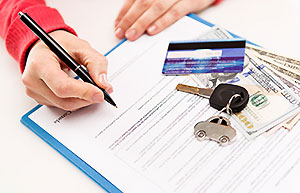The auto loan market is booming - total auto loans in the United States are up 50% from 2010 to December 2015.
But of the more than $1 trillion in auto loans outstanding, Experian estimates that between $205 billion and $388 billion are subprime loans, with 15% to 20% of those loans securitized.
We've been here before - though in much worse trouble - back in 2007.
Now, when you consider that U.S. subprime mortgages outstanding in 2007 were $1.3 trillion (based on Ben Bernanke's remarks from May 2007), and mortgage-backed securities and MBS derivatives based on those subprime loans outstanding probably totaled another $2 trillion to $4 trillion, subprime auto loans don't come close to the depth and breadth of subprime mortgages back in the day.
Still... when the subprime auto bubble pops, it's going to be messy - and smart traders are going to have the opportunity profit... if they know where to look.
Today, I'm going to break down the growing subprime auto loan bubble, including how we got here and where I think we're headed.
Then, I'll show you how to profit...
The Securitization of Subprime Auto Loans
 The mortgage meltdown that triggered the Great Recession started with late payments, and right now subprime auto loans are starting to head down the same road.
The mortgage meltdown that triggered the Great Recession started with late payments, and right now subprime auto loans are starting to head down the same road.
According to Fitch Ratings, the 60-day delinquency rate (loans at least 60 days past due) on an index of securitized subprime auto loans just hit 5.16%. That's more than during the Great Recession and the highest level since 1996.
Net losses on securitized subprime auto loans are 7.5%, based on S&P data.
The market for subprime auto loans is big and getting bigger every day because more players are getting into the business.
Besides banks like Wells Fargo and Ally Financial that make subprime auto loans, small, rapidly growing non-bank lenders backed by hedge funds, and private equity shops are popping up everywhere.
Companies that specialize in subprime lending like OneMain Holdings in Evansville, Ind., and Avant, a Chicago-based online lender who has generated $2.8 billion in unsecured personal loans since 2012 and jumped into the auto lending game, are all the rage.
Sheila Bair, the former head of the FDIC from 2006 to 2011, just joined Avant's board, citing her long-held desire to make credit more widely available. But that, of course, is another story for another time.
The reason it's so easy and lucrative for so many upstarts to get into the business and grow is that most of the loans they make are being securitized and sold off to investors.
As proof of the rapid growth of the securitization of subprime auto loans, Exeter Finance, which securitizes loans and markets them and is now the third-largest issuer of subprime auto bonds, grew its portfolio from $150 million three years ago to over $2.8 billion today.
It's a profitable business all around... but it's not sustainable. That's thanks to increasingly questionable lending practices brought about by increased competition.
It's Only Going to Get Worse
Lenders not only finance new and used cars, they finance everything from down-payments and warranties to undercoating. And believe it or not, they are now offering "cash out" refinancing.
That's right - subprime borrowers can refinance their already expensive auto loans and take cash out.
And because the game is so lucrative, increasing competition is lowering standards and making lenders stretch further and further out on the "bad borrowers" tree to find takers of their high interest rate loans.
You know this going to end badly.
Lenders typically charge between 9% and 36% interest, with 9% being pretty rare.
For comparison purposes, the average 60-month new car loan to prime borrowers is 4.05%.
The average loan term on subprime auto loans is 72 months.
While longer terms make monthly payments smaller, there's a problem with depreciation of the underlying asset while the loan's outstanding.
It's just an accident waiting to happen...
One Way to Profit from the Subprime Auto Bubble
[mmpazkzone name="in-story" network="9794" site="307044" id="137008" type="4"]
As I said, subprime auto loans imploding won't have the same impact that subprime mortgages had on the global economy. So you don't have to worry about betting on the world tumbling into another Great Recession.
That said, there aren't a lot of ways to make money on rising defaults on subprime auto loans - as of right now, banks aren't lining up to take the other side of derivative short trades.
But there is one trade that makes a lot of sense right now and can make you some good money when the bubble finally bursts.
One of the biggest players in the subprime auto loan game is Santander Consumer USA Holdings Inc. (NYSE: SC), a unit of Banco Santander SA (NYSE: SAN), the giant Spanish bank.
SC is a stock you want to short.
They're already bleeding. SC just delayed its 10-K filing twice because it was forced by securities regulators to restate three years' worth of earnings because they didn't properly account for "material weaknesses" in their loan book.
Presumably by accident, SC did not adequately provision for bad loans, which funnily enough, were worse than they knew. After adjusting "troubled debt restructurings," Santander Consumer's fourth quarter 2015 profits were knocked all the way down to $12 million... from a previously trumpeted $67.7 million.
That's bad... but believe it or not, it gets even worse.
What I find really disturbing is that in spite of that "correction," when the company restated earnings for all of 2014 and all of 2015, profits were only adjusted down 5% each year.
Something's not right there.
And, as far as guidance, the company just said in January that 2016 would be a tougher year on account of increasing competition.
Now I think you get it. This whole subprime auto merry-go-round is eventually going to throw a lot of riders off their painted ponies.
If you want to bet on the crash of the subprime auto loan game, I like shorting Santander Consumer USA Holdings at the market.
Use a tight stop if you want. But I'm going to short more on any big jumps in the stock.
Follow Money Morning on Facebook and Twitter.
One Trade to Profit from P2P Lending's Latest Headwind: P2P lenders have seen their stock prices get pummeled by various market forces. And with the SCOTUS now mulling a case that could represent a landmark in financing, things could soon get much worse...
About the Author
Shah Gilani boasts a financial pedigree unlike any other. He ran his first hedge fund in 1982 from his seat on the floor of the Chicago Board of Options Exchange. When options on the Standard & Poor's 100 began trading on March 11, 1983, Shah worked in "the pit" as a market maker.
The work he did laid the foundation for what would later become the VIX - to this day one of the most widely used indicators worldwide. After leaving Chicago to run the futures and options division of the British banking giant Lloyd's TSB, Shah moved up to Roosevelt & Cross Inc., an old-line New York boutique firm. There he originated and ran a packaged fixed-income trading desk, and established that company's "listed" and OTC trading desks.
Shah founded a second hedge fund in 1999, which he ran until 2003.
Shah's vast network of contacts includes the biggest players on Wall Street and in international finance. These contacts give him the real story - when others only get what the investment banks want them to see.
Today, as editor of Hyperdrive Portfolio, Shah presents his legion of subscribers with massive profit opportunities that result from paradigm shifts in the way we work, play, and live.
Shah is a frequent guest on CNBC, Forbes, and MarketWatch, and you can catch him every week on Fox Business's Varney & Co.



